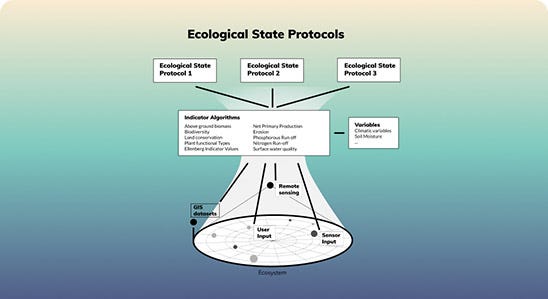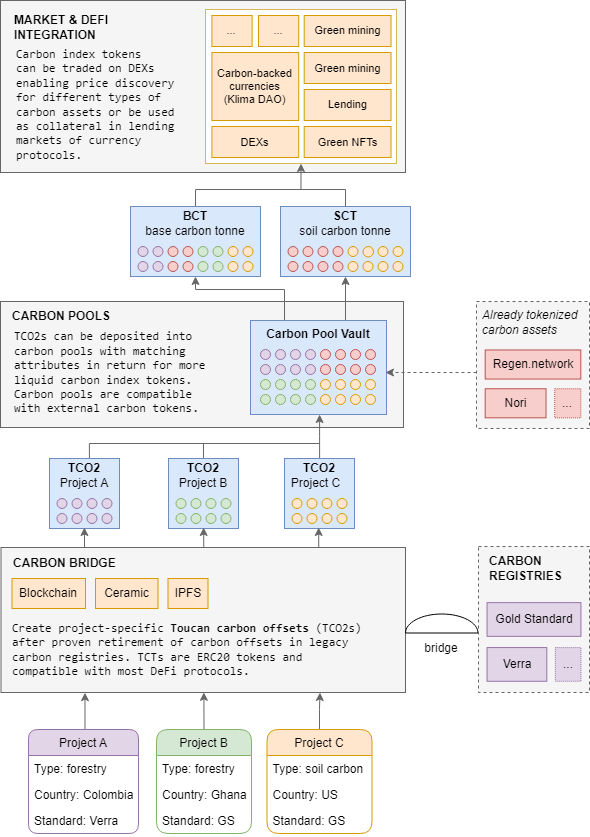👩💻Can Crypto Scale Regenerative Agriculture?
One of the most polarizing - and perhaps best marketed - subcultures of the regenerative agriculture movement is that of regenerative cryptocurrencies and tokens. Startups using blockchain technology as a way to create a nature-based ecosystem services economy have attracted capital and attention. For example, Regen Network (raised over $10.5M) and Single Earth(raised over $7.9M) are building platforms that aspire to connect off-chain data like remotely sensed data with on-chain data and information to verify claims made about an ecosystem. Though the concept is extremely appealing, the lack of consensus in best practices for verifying certain ecosystem services and the potential for missteps in carbon accounting present key barriers. Additionally, the conservation-based non-fungible tokens for philanthropy are perhaps the best-suited application for this emerging technology to expand.
Before diving deeper, I’ll note that the use of blockchain in agriculture is growing, both with startups and corporations. Be it in improving transparency across a supply chain, targeting fraudulent claims, or incentivizing producers and intermediaries to reduce waste, the benefits merit a post of their own in the future in how it can help decentralized, regenerative producers scale and gain access to new markets. Nor is this essay about crypto companies offsetting their footprint by buying nature-based carbon credits, though I encourage them to do so by buying agriculture-based carbon removal credits.
The best case made for this vision of tokenizing ecosystem services and validating them with publicly available data sources that I’ve read is from “Regen Network Economics Technical Paper”. To boil it down, the logic goes as follows: satellite data and other publicly available data sources can verify carbon sequestration, vegetative health, water quality, application of certain agri-chemicals, and more over time. If conditions are met as laid out in the hybrid smart contract, then the land stewards get an automatic reward once it is detected by an “oracle.” The wealth of ecosystem information we can get from automated sensors and remote sensing can help producers and land managers understand the impact of their practices on the land - as Regen Network puts it, “Regen Network‘s aim is to bring ecological sentience into the economy. A side effect of this will be the mainstreaming of ecological accounting, making it pervasive and affordable.” This is an easily auditable process where skeptics can replicate each step of what the startup does if they so wish and removes the manual verification layer that bogs down the carbon credit process. Regen Network in particular will verify claims against what they call “ecological state protocols”, which are essentially methodologies you can validate a carbon credit against. Nori, who also has their own token and has taken a strong thought leadership position in the space, utilizes the DayCent model to estimate carbon removed to generate credits and follows up with manual verification.
However, with these methodologies and the soil carbon world - as we’ve noted before at the Regeneration Weekly - the details of what good enough science to generate ecosystem service credits are still being settled. In a review of 17 soil carbon protocols, the non-profit CarbonPlan rated both Regen Network and Nori’s initial methodologies as tied for the lowest score possible. In a further analysis of Regen Network’s initial sale of credits to Microsoft, a group of Australian scientists raised numerous granular concerns with the science used to generate the credits from Murdoch-owned farms to Microsoft, which, to Regen Network’s credit, they took as a learning opportunity. Nonetheless, as the CarbonPlan report notes, Regen’s “Projects credited to date have included significant deviations from the stated methodology.” To Nori’s credit, though I disagree with their lack of requiring soil sampling as laid out in their methodology, their credits generated are all internally aligned - at least allowing the market to have a consistent interpretation of each Nori token.
Fundamentally, an ecosystem service token is only as good as the underlying science used to generate it. In a field like regenerative agriculture where finding affordable measurement of soil carbon is still evolving, and the use of remote sensing to generate credits is not yet widely accepted, those questions should be settled before we get into any discussions about the merits of tokenizing. Generating liquidity into the emerging carbon markets is an important consideration, but that should not come at the expense of standardizing what a verifiable, high-quality carbon removal offset is. If not, buyers will be expected to conduct a level of diligence for purchases that price themselves out of the market. There are plenty of methodology-level kinks to sort out before we complicate matters with a whole other host of problems of getting credits on the blockchain. Other mechanisms of injecting liquidity and making carbon removal credits accessible to emerging buyers exist: see the work of intermediaries and brokers not on a blockchain like Pachama, Patch, or Cloverly.
In allocating resources, rigorous carbon accounting should be a priority. Another group making noise with token-enabled carbon credit purchases is called KlimaDAO (DAO stands for decentralized autonomous organization). This group has pooled enough money to buy over 13 million carbon credits from respected registries. The goal is to create a digital currency backed by these credits, which were taken from the Verra registry and transformed into “Base Carbon Tonne”(BCT) Tokens from another body called Toucan. Two key issues arise from this process. The first is the type of credit targeted: the credits are Verra certified, but the vintage (year credit is generated) can be all the way from 2008. The vintage year is a key consideration to credit buyers and price, meaning that many of the credits being purchased are fundamentally worthless in so far as they enable carbon projects. This does ostensibly move the floor upwards in the carbon market, but many buyers would have still avoided these credits due to greenwashing concerns. Additionally, as Chris Sacca notes, the focus of such capital would be better placed on carbon removal technology and credits. The second key concern of mine is highly technical. In effect, when Klima is buying these cheap credits and putting them in their registry, they’re turning them into BCT Tokens first. In doing so, they have to retire the credit from the Verra registry to generate the token. This leaves open for the BCT token what is called double-counting: a buyer of a Verra registry credit could retire the credit in their own carbon-neutral claim and then proceed to generate the BCT token and resell the carbon or re-retire it as a BCT token. Though some safeguards are probably in place, it adds another layer of diligence for the whole market instead of greater transparency.
Crypto can be a strong tool for the conservation-minded. Perhaps rather than generating carbon credits, focusing on philanthropic non-fungible tokens like those of Project Ark, who is collaborating with the World Wildlife Foundation, is a better near-term course of action to achieve a proof-of-concept. In particular, DAOs or specific NFT purchases guided towards mandated land restoration present an ocean blue. For instance, Tupan’s token is “equivalent to One Cubic Meter of Native Preserved Amazonia Forest.” Chainlink, which is the most widely used oracle network for powering hybrid smart contracts, awarded a research grant to the Green World Campaign to track outcomes of their afforestation and eco-agriculture campaigns. As we push forward the science on soils, remote sensing, and blockchain, this regenerative, blockchain-based vision should become the norm - but that will not happen overnight, especially with assets like carbon credits that hold regulatory weight. The science comes a priori to the blockchain, though the latter can be in service to the former.
Further Consumption:
Can Cryptocurrencies Save the Planet?
Blockchain can help us beat climate change. Here's how.
Gregory Landua, the role of blockchain in regenerative agriculture, and much more
TheoryMesh: Blockchain for Agriculture
Bitcoin, Carbon Credits And Regenerative Farming
Shop: Need a last-minute Christmas present? Consider buying a couple of carbon credits from Grassroots Carbon, a startup I work with that generates credits from American regenerative ranches. Credits are independently verified and certified by a carbon storage standard called BCarbon and come with a certificate. Each carbon credit represents the certified removal of one ton of CO2 from the atmosphere, stored in healthy grassland soils. Feel free to buy here - or reach out to me if you want to see our offerings for businesses!
Disclaimer: The Regeneration Weekly receives no compensation or kickbacks for brand features - we are simply showcasing great new regenerative products.
If you have any products you would like to see featured, please respond to this newsletter or send an email to Kevin(at)soilworksnaturalcapital.com
The Regeneration is brought to you by Wholesome Meats | Soilworks | Grassroots Carbon| Grazing Lands





